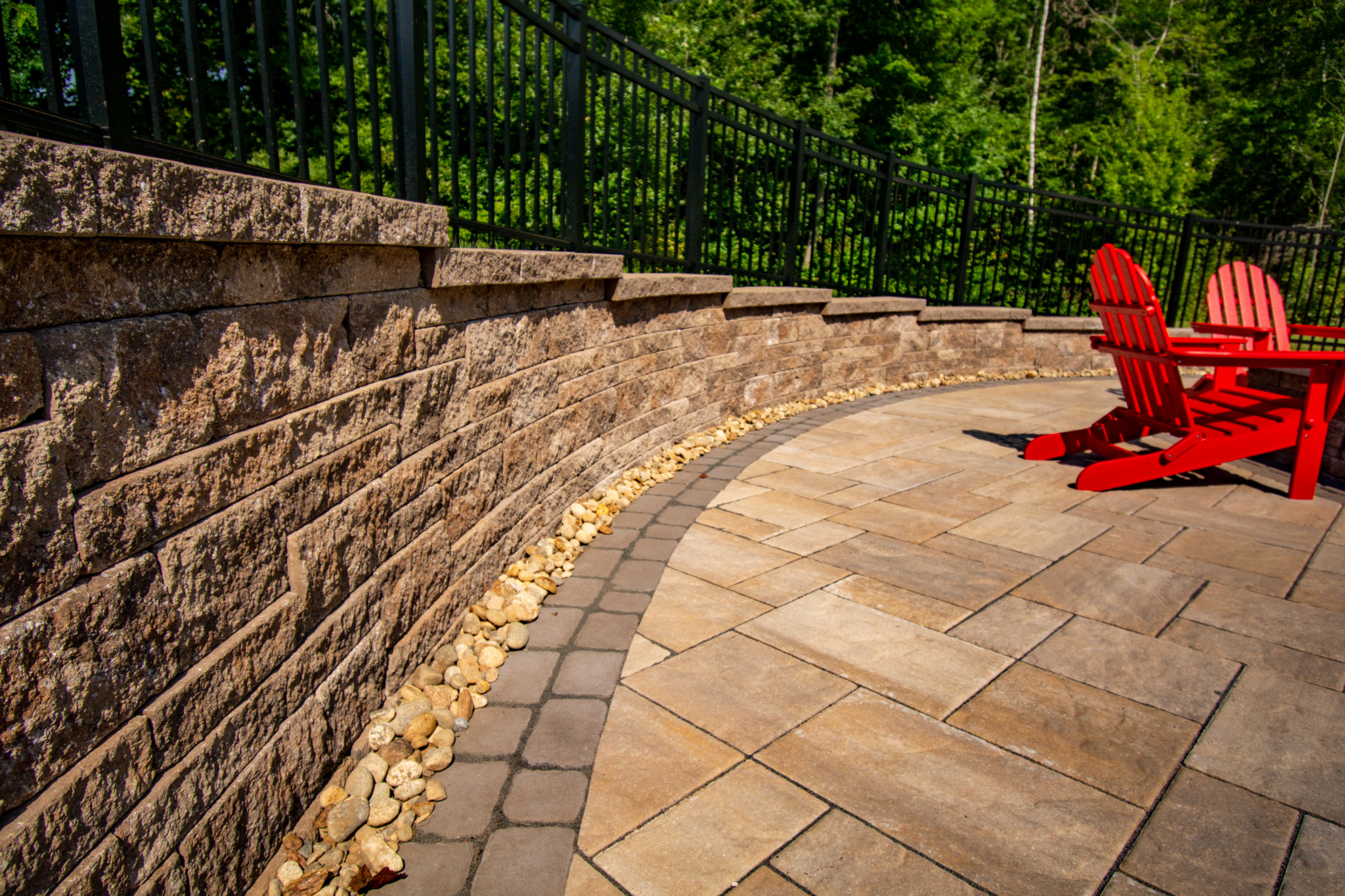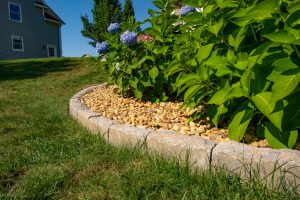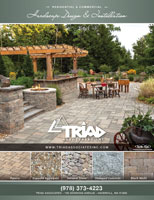
Designing the exterior of your home doesn’t always feel as fun as designing the interior because it may not seem like there are as many options – but that isn’t true. There is such a wide variety of materials to choose from to create your hardscape, offering endless possibilities for designing your space. From pavers to water features to lighting, you can mix and match in unique ways that express your personal style and make your home look amazing.
Some of the most overlooked hardscaping materials are various types of gravel and crushed stone. These hardscaping cornerstones not only serve a functional role in helping to manage water drainage and keeping down weeds, but when used properly, they can also accentuate the design of a hardscaped area.
What Is Gravel?
Gravel looks like small rocks, and it is often composed of limestone, sandstone, or basalt. Gravel is created through a natural process of erosion, which reveals small and irregular pieces of rock. Gravel is used in hardscaping in a variety of ways, but it is often the material of choice for foundational beds for pavers, concrete, and asphalt.
How Is Gravel Different from Crushed Stone?
Gravel and crushed stone can look very similar, and they are often mistaken for one another. However, they are different in key ways. Gravel is a naturally occurring product, while crushed stone is manufactured. As a result, gravel tends to have a smoother surface and rounded edges, while crushed stone is more irregular with sharper edges. Gravel also tends to be smaller than crushed stone.
Crushed Stone and Gravel Can Be Classified in Different Ways
When you begin shopping the different types of gravel and crushed stone, you will see that they are classified in different ways. Understanding these classifications and what they mean will help you get the right stone for your project, ensuring that it not only looks the way you want but also functions as needed. Your hardscape contractor can also guide you through the selection process to ensure you get the right classification of gravel or crushed stone for your project.
Classification by Size
One of the most common ways you will see gravel and crushed stone classified is by size. Typically, you won’t see a descriptor like “small” or “large” on the gravel or stone, but rather a number. Understanding what these numbers mean is key to knowing the sizing.
Gravel is classified from a 1 to a 10, going from largest to smallest. #1 is the largest size available for gravel, with particles between 2 and 4 inches in diameter. A #3 classification refers to pieces between ½ inch and 2 inches in diameter. A #5 classification refers to particles 1 inch or smaller in diameter. A #8 classification refers to pieces between ⅜ inch and ½ inch in diameter. Finally, a #10 classification is for pieces that are just “screenings” or “dust.” These are fine particles left behind after the larger pieces are removed.
Crushed stone has many different classifications. One of the most common is #57, which refers to pieces between ¾ inch and 1 inch in diameter. This type of crushed stone is often used as a base for building projects, including driveways and patios. A #3 classification refers to stone that is ½ inch to 2 inches in diameter, used for projects requiring a thicker, four-inch base. A #411 classification is another popular choice, a mix of #57 stones and screenings or dust.
Washed vs. Unwashed Gravel
 “Washed” and “unwashed” types of gravel aren’t references to the cleanliness of the stone. Instead, “washed” gravel has a smoother surface than unwashed. Washed gravel is sometimes referred to as river rock, often used in decorative applications such as filling in around pathways or garden beds. Unwashed gravel is often used for drainage projects.
“Washed” and “unwashed” types of gravel aren’t references to the cleanliness of the stone. Instead, “washed” gravel has a smoother surface than unwashed. Washed gravel is sometimes referred to as river rock, often used in decorative applications such as filling in around pathways or garden beds. Unwashed gravel is often used for drainage projects.
Classification Based on Stone Type
Gravel and crushed stone are also often classified based on the type of stone. For example, you can have limestone, bluestone, or caliche. It is important to work closely with your hardscaping contractor to understand how each of these different materials may benefit your project specifically.
There Are Some Specialty Types as Well
There are many specialty types of gravel that you may want to consider based on your project’s needs or the aesthetic you desire. For example, lava rock is a light and porous stone made from cooling lava, popular in landscaping. Marble chips and river rock are other popular specialty types.
Popular Types of Gravel
Some types of gravel have become more popular thanks to their beautiful look and versatility. Explore the options for using these popular types of gravel in your space with your hardscaping contractor:
Pea Gravel
Pea gravel lives up to its name: It is small, round, and smooth. It is a popular option as an accent stone in larger design projects, such as next to a pathway or around pavers.
Crushed Stone Gravel
Crushed stone comes in various colors and sizes. Elegant marble chips can elevate your project, as can beautiful and durable stones like granite.
River Rock Gravel
River rock is a popular choice because it is a larger stone with smooth, round edges. It is ideal for filling in spaces where you want to accent the design.
Decomposed Granite Gravel
Decomposed granite gravel has been weathered and eroded over time in quarries, giving it a finer appearance. It comes in a variety of colors, providing flexibility in your design choices.
Mexican Beach Pebble
Mexican beach pebble is similar to river rock, with a smooth appearance, though it is usually smaller. These small stones have gorgeous colors that will accentuate just about any hardscaping project.
Rip Rap
Rip rap consists of larger stones popular for their effectiveness in managing drainage or stopping erosion. They are great for filling in drainage swales, as a natural retaining wall, or around garden beds.
Selecting the Right Gravel Type for Your Project
There are many factors to consider to ensure that you choose the right gravel type for your hardscaping project. The best thing you can do is work closely with your Triad Associates hardscaping contractor for tailored recommendations. Some of the guidance your contractor will provide includes:
Factors to Consider When Choosing Gravel
 You’ll need to think through your goals for your project when choosing your gravel. If you want to pave a driveway, you’ll need a different type of gravel than if you were just creating a walkway. In addition to understanding the project’s needs, you also need to consider the drainage requirements of the area. Will you need gravel that can handle that? Finally, choose gravel that contributes to the aesthetic you are trying to create. Consider the color, size, and texture of the gravel and how they will contribute to the final look.
You’ll need to think through your goals for your project when choosing your gravel. If you want to pave a driveway, you’ll need a different type of gravel than if you were just creating a walkway. In addition to understanding the project’s needs, you also need to consider the drainage requirements of the area. Will you need gravel that can handle that? Finally, choose gravel that contributes to the aesthetic you are trying to create. Consider the color, size, and texture of the gravel and how they will contribute to the final look.
Make the Right Choice Based on Your Needs
Every project will have different gravel needs, and your contractor will help you understand them. Drainage and load are top considerations. For example, if you are paving a driveway, you will need a gravel base that can support the weight of vehicles while also allowing drainage to pass under the driveway without undermining its integrity. You’ll have to choose the right size and hardness of gravel and ensure it is laid in the right thickness.
Uses of Gravel in Hardscaping
There are so many ways to use gravel in your hardscaping. You can lay down a bed of gravel to use as a walkway from your driveway to your entryway, or from your garden beds to your patios or other areas of your property. You can also put gravel around your paved walkways as a design accent. Gravel can be used for a patio or patio accent, fill in around your garden beds in place of mulch, or fill in around your pavers in your patio or driveway. You can also use gravel for your driveway, providing an eco-friendly and inexpensive alternative to concrete or asphalt paving. Explore the options with your contractor.
Work with Triad Associates’ Hardscaping Experts
The hardscaping experts at Triad Associates have been designing and installing gravel and crushed stone hardscaping projects for homes and businesses throughout the Haverhill area for the last four decades. We have earned a reputation for our eye-catching designs, professional service, and long-lasting results. Call us today to schedule a consultation with one of our designers and start exploring how you can use different types of gravel to elevate your property’s exterior. Our designers are ready to design a new hardscape for you or to redesign or elevate your current hardscape. Call us today at (978) 373-4223 to get started!




